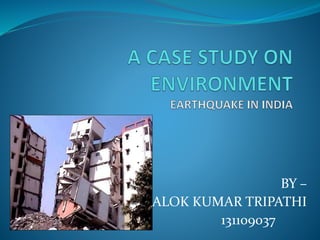A case study on environment alokh
- 1. BY ŌĆō ALOK KUMAR TRIPATHI 131109037
- 2. CASE EXAMPLE ŌĆō EARTHQUAKE IN CITY OF BHUJ (GUJARAT) ’éŚ Date of occurrence: January 26,2001. ’éŚ Intensity: 7.9 (Richter scale) ’éŚ Casualty: 7000+ died 35000+ injured 1 lakh rendered homeless 100+ multi-storeyed collapsed ’éŚ 26 January being Republic Day, many students and teachers died during procession of parade.
- 5. WHY WAS THIS EARHQUAKE SUCH A HUGE DISASTER ? ’éŚ A Combination of natural and human factors contributed to the death toll and damage. ’éŚ India sits in a region that is seismically active. ’éŚ Dishonest contractors had created weak structures , disregarding building codes , with the cooperation of corrupt officials ’éŚ Building inspectors were accused of demanding bribes and neglecting to enforce construction standards. ’éŚ Cities affected were larger and denser than in the past due to rapid growth in India.
- 7. ’éŚ The country was ill ŌĆōprepared to deal with a disaster of this magnitude . A large earthquake (6.8 on Richter scale ) hit Washington just a month after the earthquake in Gujarat, but there was only one death. ’éŚ These two earthquakes had very different natural, economic, and political situations, which contributed to very different outcomes.
- 8. CONCLUSION ’éŚ Government should work on disaster management more effectively. ’éŚ Building norms and regulations should be strictly followed. ’éŚ Construction must be avoided on seismic prone zones. ’éŚ Mock drill should be conducted on regular intervals in such areas. ’éŚ Public awareness programmes can be carried out in collaboration with NGOs. ’éŚ Existing structures should be reinforced.
- 9. REFERENCES :- ’éŚ McGraw-Hills ’éŚ Google images THANK YOU








